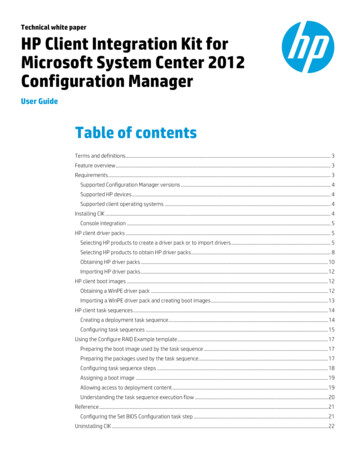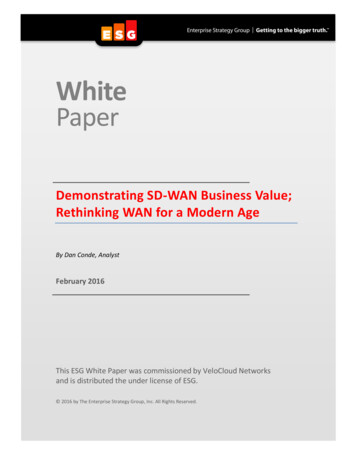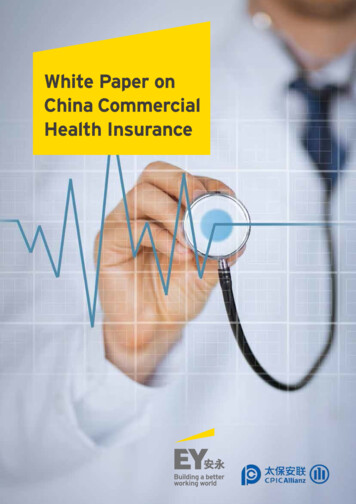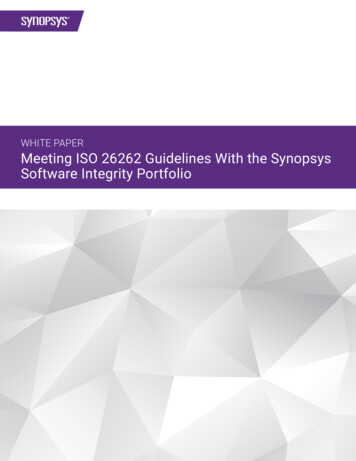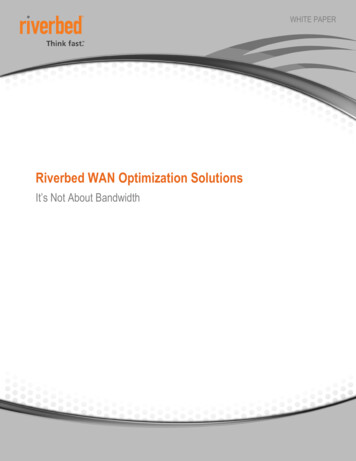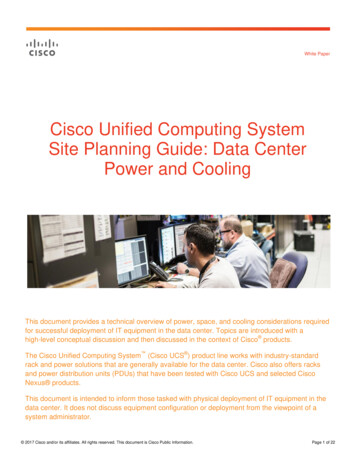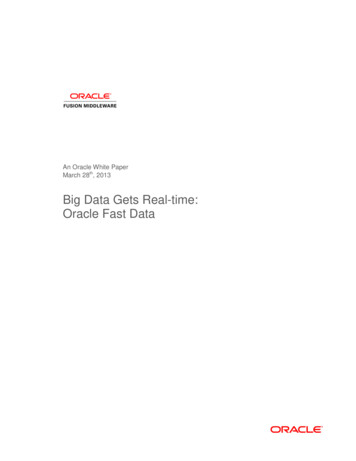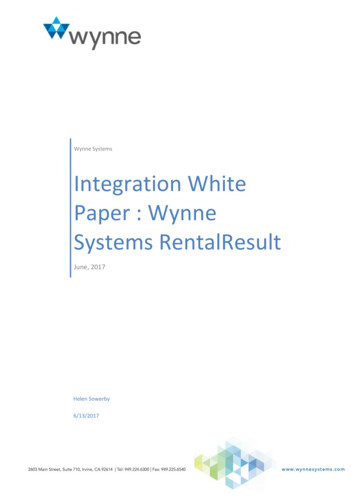
Transcription
Wynne SystemsIntegration WhitePaper : WynneSystems RentalResultJune, 2017Helen Sowerby6/13/2017
Wynne SystemsPage 2 of 19Integration Tools3Introduction3Integration Architecture3Security Flow for Integration architecture5High Level examples of existing ERP integrationsOracle & Wynne RentalResult55Scenario 1: full scale integration to Oracle EBS6Scenario 2: Limited Integration to Oracle EBS7Example of Oracle Integration at Customer X8SAP & Wynne RentalResultExample of SAP Integration at Customer YHigh Level CRM IntegrationsWynne RentalResult with CRM Applications10101212Scenario 1: Integration of Customers, Prospects & Contacts12Scenario 2: Integration of Detailed transactional information13Wynne RentalResult with Telematics13Telematics Background Poller13A typical flow for a plugin is the following, for each polling cycle14
Wynne SystemsPage 3 of 19INTEGRATION TOOLSIntroductionThe Wynne RentalResult suite has a full web services platform using SOAP or RESTful web services to managedata movement between systems. For those systems where real-time communication is not appropriate orpossible we can also interface using flat file or scheduled transactions. This document concentrates on ERP andpoint based Integration utilizing SOAP or RESTful web services.A web services exchange example is included at the end of the document in the telematics section.Integration ArchitectureThe Wynne RentalResult system is a modern N-tier architecture based on the Java (JEE)/Spring Frameworkplatform and is composed of the following layers as shown 1 below.
Wynne SystemsPage 4 of 19The following core components make the integration platform:Credit Card: the Wynne RentalResult server can take credit card payments as part of some business processesvia a credit card payment gateway interface plugin mechanism. Currently Paymetrics and Cybersource aresupported but new plugins can be written for other payment gateways.Outbound Interfaces: Trigger points in the business logic can cause XML messages to be sent to the ESB forrouting to 3rd party systems (accounts, invoices, etc.). The transport mechanism can differ depending on thecustomer integration requirements. For instance we have integrated with Oracle and SAP using SOAP over HTTPand with IBM WebSphere MQ using SOAP over JMS.Telemetric: the Wynne RentalResult server can periodically connect to telemetric services such as Qualcommor Topcon to collect asset sensor/geolocation information.Tax Adapter: Wynne RentalResult can be configured to connect to a Vertex tax web service.Spring Remoting: for in-house Java applications that need to run on separate servers (such as the WynneRentalResult e-commerce server), the spring remoting protocol can be used for Java to Java fast RPC calls.REST API endpoints: the Wynne RentalResult system provides a REST API for native mobile applications(Android, iOS), native Java or non-Java applications (.NET WinForms apps) and web applications to accessresources and update data in Wynne RentalResult. This makes it possible for Wynne RentalResult to coexist in acomplex web environment where data needs to be collected (mashed) from various systems but presented in aunified user UI web experience. This makes the architecture completely open to programming by following thebest REST design and principles.File Batch Import: sometimes 3rd party systems need to import into Wynne RentalResult large amounts of data(assets/accounts) at periodic intervals. CSV type files can be scanned in shared network directories for thatpurpose.Inbound Interfaces: traditional SOAP type web services are available for enterprise to enterprise integration.This is used for importing data in real-time into Wynne RentalResult. In a lot of our integration projects, a 3rdparty system like Oracle or SAP is set up for bidirectional integration with Wynne RentalResult. For instanceOracle would export A/R accounts to Wynne RentalResult by calling the ImportAccount web service and WynneRentalResult would call an Oracle web service whenever an account is updated in Wynne RentalResult (via theoutbound interface component and the ESB transform/routing technology).
Wynne SystemsPage 5 of 19Security Flow for Integration architectureThe RentalResult architecture utilizes the Spring OAuth2 extension library to provide OAuth2 authentication tothe RentalResult platform. We currently have the 2 following flows supported:Password flow:The users RentalResult credentials are passed to the /OAuth/token endpoint using the password grant type. Abearer token is passed back to the client application and each subsequent calls must contain the bearer tokeninside the authorization HTTP header parameter. This flow is used by the iOS/Android mobile applications,where the username/password are entered by the user using a login screen. All communications to the backendserver are conducted over HTTPS.JWT Bearer token flowThis is a custom flow used at RentalResult to secure our REST and SOAP API layers. The client applicationprogrammers are given a key by the RentalResult support team. The key must be used to compute a JWTassertion that is then passed to the /OAuth/endpoint token. Just like the password flow, in the JWT bearer flow,a bearer token is sent back to the client application and must be passed as part of subsequent REST/SOAP callsusing the authorization HTTP header parameter.HIGH LEVEL EXAMPLES OF EXISTING ERP INTEGRATIONSOracle & Wynne RentalResultThe depth of your integration between Oracle and RentalResult is entirely up to you. Existing implementationsrange from simple master data (project & customer) and GL postings, to real time complex integration at everylevel. This section aims to lay out 2 scenarios, currently used by different Oracle customers who use WynneRentalResult to run their equipment management businesses.
Wynne SystemsPage 6 of 19Scenario 1: Full Scale Integration to Oracle EBSWhere the equipment business is tightly bound into the corporate entity, or where the equipment business isthe corporate entity we normally expect a full scale integration between the systems. Master data is largelymanaged in Oracle, vendor, customer, project, asset and financial data all pass between the systems in real timeand user roles encompass both applications.General LedgerAR & BillingAP & PurchasingProjects, Internal Charges and AccrualsFinancial Asset ManagementEquipment Mobilization and Physical AssetManagementMaintenance and ServicingThe Oracle GL is the only system of record, data is fed to the GLthrough the subsidiary ledgers.Invoices and charge documents relating to equipmentmovement/usage, rentals or operation equipment timesheets areraised in RentalResult and sent through to Oracle AR. Credit ismanaged though Oracle unless you specifically want to manage aseparate equipment credit limit through RentalResult.If you are renting equipment in from external vendors then youneed to manage rental purchase orders. RentalResult can managethis directly from within the equipment management process andmake the Oracle AP matching process as streamline as possible.We create and approve the PO in RentalResult and replicate intoOracle. We then create goods receipt documents in Oracle foreach billable period of time as it is reached so that you can applymultiple date based purchase invoices to the PO. All purchasingassets destined for the asset register is handled in Oracle, withOracle as the financial system of record for your assets.Oracle is the system of record for all project data. All activity inRentalResult can be linked to project information and any datasent back to Oracle will include project details. If you need toprovide job sites or customers with weekly or monthly projectaccruals by task codes then we can generate the relevant accrualsfor you and interface to Oracle projects.In this scenario we would expect all financial asset management tobe done in Oracle unless you have a different preference. Oracleholds the master data.All transactional events which affect location, status or usage ofthe asset are managed through RentalResult. This means that thephysical asset it managed in RentalResult. Logistics, movements onand off job sites, rental deliveries and confirmations, and the offrent or de-mobilization process are all managed throughRentalResult. This includes all mobilization and physicalmanagement of externally rental assets and may includeconsumables.If the only maintenance that you need to manage relates to theequipment that you are managing through RentalResult wewould recommend that you utilize RentalResult maintenance andservice applications. In which case anything that affects the valueof an asset – i.e.: if you do any refurbishing work, or anything thatadds to the asset costs then the data will be sent though toOracle. If you are already using Oracle’s maintenance andservicing applications then instead we will use transactional andstatus change events to trigger activities in Oracle. Asset statuscan be used to all or disallow behavior in RentalResult. Forexample; until a service is confirmed as being performed inOracle the user will not be allow to dispatch the asset inRentalResult.
Wynne SystemsPage 7 of 19Scenario 2: Limited Integration to Oracle EBSIn some instances we have customers who are looking for an integration which is limited to specific key functionand data. This tends to be where the equipment management business is acting as a sub-contractor to the mainbusiness and there is a degree of distance required between the two businesses. In this instance we often findthe groups of people using Oracle and Wynne RentalResult are almost entirely distinct, there is virtually nooverlap of systems from an end user point of view.General LedgerAR & BillingAP & PurchasingProjects, Internal Charges and AccrualsFinancial Asset ManagementEquipment Mobilization and Physical AssetManagementMaintenance and ServicingThe Oracle GL is the only system of record, data is fed to the GLthrough the subsidiary ledgers and from RentalResult AR andasset register.Invoices and charge documents relating to equipmentmovement/usage, rentals or operation equipment timesheets areraised in RentalResult and the credit collection process ismanaged entirely in RentalResult. Credit is managed inRentalResult.All purchasing of equipment, rental purchasing and consumablesfor maintenance and servicing are managed within RentalResult.Purchase orders are approved, received and matched withinRentalResult. Matched invoices are sent through to Oracle AP forpayment.Oracle is the system of record for all project data. All activity inRentalResult can be linked to project information and any datasent back to Oracle will include project details. If you need toprovide job sites or customers with weekly or monthly projectaccruals by task codes then we can generate the relevant accrualsfor you and interface to Oracle projects. Oracle projectrequisitions can be used to initiate the equipment managementprocess.In this scenario we would expect all financial asset management tobe done in RentalResult unless you have a different preference.RentalResult holds the master data for all assets related to theequipment management or rental business. Asset cost, value anddepreciating data will be sent through to Oracle GL as journals.All transactional events which affect location, status or usage ofthe asset are managed through RentalResult. This means that thephysical asset it managed in RentalResult. Logistics, movementson and off job sites, rental deliveries and confirmations, and theoff-rent or de-mobilization process are all managed throughRentalResult. This includes all mobilization and physicalmanagement of externally rental assets and may includeconsumables.All ad-hoc and scheduled maintenance is carried out usingRentalResult maintenance and servicing applications. Anythingthat affects the value of an asset – i.e.: if you do any refurbishingwork, or anything that adds to asset costs, costs of parts andlabor on schedule maintenance will be sent through to Oracle asa journal
Wynne SystemsPage 8 of 19Example of Oracle IntegrationIn October 2011, customer X (available as a reference) introduced a new financial software solution across alltheir businesses. This solution involved the integration of Wynne RentalResult, their rental fleet operationalmanagement software, with a financial solution provided by Oracle which includes R12 and OLFM. Theintegration between RentalResult and the Oracle solution allowed for information crucial to handling thefinancials to flow automatically from RentalResult to Oracle and any financial information that affects operationsto flow back from Oracle.The integration was achieved with the use of web services transferring industry standard SOAP based messagesover HTTP. The solution included a number of both inbound services allowing for data to be pushed out of Oracleto RentalResult and outbound services allowing for data to be pushed to Oracle based on the appropriate triggerbeing activated in RentalResult.The services within RentalResult connected to a number of services created within Oracle’s middleware SOAsuite. This allowed Oracle to wrap up a number of their API’s and open interfaces into SOAP based web servicesas well as perform both inbound and outbound message transformation. The table below summaries theinterfaces between RentalResult and SOA giving a summary of the functionality provided. This along with theinterface diagram gives an overview of the interfaces available and data being transferred in the Customer Xsolution.Interface NameDescriptionInterface DirectionVendorCreates and updates vendor accounts in RentalResult basedon supplier data exported from OracleOracle to RentalResultContract CreditApprovalInitiates order approval process in Oracle and allows fordecision to be updated against contract in RentalResultBothCustomer CreditUpdates credit status on customer accounts in RentalResultOracle to RentalResultCustomerCreates an account in Oracle based on account data inRentalResultRentalResult to OracleAssetCreates an asset in RentalResult and allows for revaluation ofthe asset based on external depreciationOracle to RentalResultPurchase OrderCreates purchase order in Oracle based on PO data inRentalResultRentalResult to OracleGoods in ReceiptCreates assets in Oracle on receipt of assets into RentalResultRentalResult to OracleSales InvoiceExports sale invoice to Oracle and retires assets at saleRentalResult to Oracle
Wynne SystemsPage 9 of 19 As you’ll see from the diagram below, it was decided that where purchasing related directly to a rentalor sales order it was triggered from RentalResult and then used to electronically create a PO in Oracle,the receipt was then performed in RentalResult and again electronically pushed to Oracle. Where purchasing was driven more by the business – i.e.: replenishment of the rental fleet, of partsetc., the PO was initiated in Oracle and rental assets are received in Oracle and then sent through toRentalResult. This concept is something that we have also used elsewhere particularly around sub rentals whereOracle’s difficulty with matching multiple invoices to a single GRN means that the slickest solution is tomanage the whole of the sub rental purchase and receipt in Wynne RentalResult, interface thedocuments electronically to the Oracle AP, and then auto-send a new goods receipt and PO line foreach sub-rented asset if it stayed on rent beyond the initial period to allow Oracle AP matching to occurseamlessly.RentalResult/Oracle Integration at Customer XVendor(RR)/Supplier (R12) InterfaceAsset (Create, Reevaluate)OLFM (OracleLease &FinanceManagement)Customer (Create, Amend)Customer (Update)WynneRentalResultOrder Approval (Request)Order Approval (Response)Oracle SOASuiteOracle R12Purchase Order (Create, Cancel)Goods in Receipt (Create, Cancel)Sales Invoice (Create)
Wynne SystemsPage 10 of 19SAP & Wynne RentalResultThe diagram and notes below provide an example of the type of integration we have with SAP for a large rentalcompany in the USA (available as a reference). We also support some customers still feeding data to SAP viaold-style BAPI interfaces and with much more simplified structures. For example AR invoices and asset valuesonly. As in all cases, it is easy to tailor the Wynne RentalResult interfaces to fit your specific businessrequirements.Example of SAP IntegrationRental RequisitionsInter-depotTransftersSAP & AllocationNote 1GoodsReceiptSAP APNote 4ContinuationInvoicingPicking& DispatchNote 2MaintenanceNote 3SAP ARReturnInvoicingPickup &ReturnDamageInvoicingLoss &DamagesNote 6SAP GLNote 1: Assets are bought and received into the asset register in SAP. The asset master resides in SAP.At a point in time the assets are marked as being part of the rental fleet in SAP and this triggers aninterface into RentalResult to make the asset visible to the rental system. At this point the rentalsystem takes physical ownership of the asset, and any status changes against the asset are managedin the rental application until such time as it is sold, lost or retired from the rental fleet.
Wynne SystemsPage 11 of 19Note 2: Maintenance activity is normally carried out in the SAP system, but can be done withinRentalResult if necessary. You will capture service units such as clock hours within the rental processand this information is sent to the SAP system to assist with management of maintenance activities.Note 3: All rental invoices and billing data is captured and created in RentalResult and the invoicesare then sent straight through to the SAP AR. All Cash collection, etc. is performed in SAP.Note 4: The customer master resides in SAP and is interfaced directly through to the RentalResultapplication in real time, so that credit checks etc. can be performed directly from Quotation and RentalContract entry in RentalResult. In the simple model a new customer needs to be set up in SAP beforeit can be used in RentalResult. You can also use a two interface which would allow a customer to becreated in RentalResult and then sent through to SAP.Note 5: We do not update the GL directly from the billing process, SAP’s interfaces are structured sothat when you load billing documents into the AR, the AR itself makes its own postings. We can supplythe invoice data down to the lowest level of detail (asset number etc.) so that your postings can reflectyour business requirements.Note 6: If any data is captured at an asset level that needs to be reflected in the SAP GL or AssetRegister this is sent as journal data. This may include damage charges, loss information or other valueswhich are captured naturally as part of the rental process.
Wynne SystemsPage 12 of 19HIGH LEVEL CRM INTEGRATIONSWynne RentalResult with CRM ApplicationsWe provide standard interfaces for two different levels of integration.Scenario 1: Integration of Customers, Prospects & ContactsThis level of integration provides basic data flow between the Wynne RentalResult platform and the CRM systemof your choice, existing customers utilize Salesforce, Zoho and MS Dynamics.If your CRM system is used for tracking customer interactions, mailshots, etc. then this type of integration willserve your needs.Integration between CRM & Wynne RentalResultLead/Customer/Contact Data from CRM to RentalResult Create new lead in RentalResult (link to quote)Amend lead in RentalResultAmend customer detailsRequest creation of customer from leadCreate contact in RentalResultAmend contact in RentalResultLead/Customer/Contact Data from CRM to RentalResult Request list of leads from RentalResultRequest specific lead from RentalResultRequest rental related information for customer accountRequest list of contacts (shipping, etc.) from RentalResult
Wynne SystemsPage 13 of 19Scenario 2: Integration of Detailed Transactional InformationThis takes CRM i
Tax Adapter: Wynne RentalResult can be configured to connect to a Vertex tax web service. Spring Remoting: for in-house Java applications that need to run on separate servers (such as the Wynne . This is a custom flow used at to secure our REST and SOAP API layers. The client application Re
